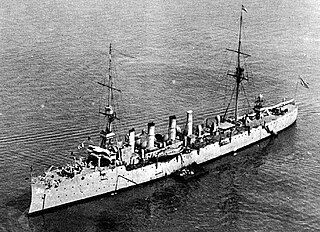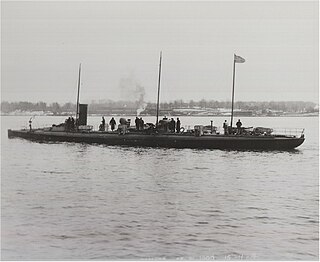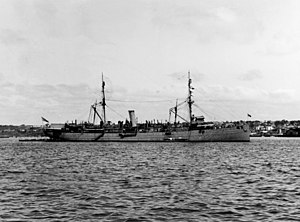
USS Massachusetts was an Indiana-class, pre-dreadnought battleship and the second United States Navy ship comparable to foreign battleships of its time. Authorized in 1890, and commissioned six years later, she was a small battleship, though with heavy armor and ordnance. The ship class also pioneered the use of an intermediate battery. She was designed for coastal defense and as a result, her decks were not safe from high waves on the open ocean.

USS Kentucky (BB-6), was the second and final Kearsarge-class pre-dreadnought battleship built for the United States Navy in the 1890s. Designed for coastal defense, the Kearsarge-class battleships had a low freeboard and heavy armor. The ships carried an armament of four 13-inch (330 mm) and four 8-inch (203 mm) guns in an unusual two-story turret arrangement. The Newport News Shipbuilding Company of Virginia laid down her keel on 30 June 1896. She was launched on 24 March 1898 and was commissioned on 15 May 1900.

The first USS Newark (C-1) was a United States Navy protected cruiser, the eighth protected cruiser launched by the United States. In design, she succeeded the "ABC" cruisers Atlanta, Boston, and Chicago with better protection, higher speed, and a uniform 6-inch gun armament. Four additional protected cruisers were launched for the USN prior to Newark.

The first USS Dixie was a United States Navy auxiliary cruiser and later a destroyer tender. The Dixie was the first ship of the United States Navy to have this name.

USS Chester (CS-1/CL-1) of the United States Navy was the first scout cruiser (CS) built for the Navy. In 1920, she was reclassified as a light cruiser (CL). She was launched on 26 June 1907, by Bath Iron Works, Bath, Maine, sponsored by Miss D. W. Sproul, and commissioned on 25 April 1908. She was named in honor of Chester, Pennsylvania. In July 1928, long since decommissioned, her name was changed to USS York, in honor of York, Pennsylvania.

USS Birmingham (CS-2/CL-2), named for the city of Birmingham, Alabama, was a Chester-class scout cruiser, reclassified a light cruiser in 1920. Entering service in 1908, the ship became known for the first airplane takeoff from a ship in history in 1910. During World War I, Birmingham escorted convoys across the Atlantic. The cruiser was decommissioned in 1923 and sold for scrap in 1930.

USS Salem (CS-3/CL-3), Scout Cruiser No. 3, was a Chester-class scout cruiser of the United States Navy. She was the first Navy ship named for the city of Salem, Massachusetts.

The fourth USS Columbia (C-12/CA-16) was a protected cruiser in the United States Navy during the Spanish–American War and World War I. She was the lead ship of her class of two cruisers; her sister ship was Minneapolis (C-13). The class was originally designed with three funnels; however, Columbia was built with four and Minneapolis with two. This may have been to make them resemble specific passenger liners.

USS Solace (AH-2) was a hospital ship in the United States Navy. Solace was built in 1896 and 1897 by the Newport News Shipbuilding & Drydock Co., Newport News, Virginia, and was operated as the SS Creole by the Cromwell Steamship Lines. The ship was acquired by the United States Navy on 7 April 1898, renamed Solace, and converted into a hospital ship. She was the first Navy ship to fly the Geneva Red Cross flag. Solace was commissioned on 14 April 1898.

The fourth USS Montgomery (C-9), the lead ship of her class, was an unprotected cruiser in the United States Navy authorized in the Naval Appropriations Act of September 7, 1888. Montgomery served during the Spanish–American War and in World War I and was named for Montgomery, Alabama.

USS Hawk (PY-2/IX-14) was the converted British-built civilian yacht Hermione of 1891, acquired for service as a patrol yacht in the Spanish–American War. She later served in the Ohio and New York naval militias and on the Great Lakes until decommissioned in 1940.

The second USS Miantonomoh, an iron‑hulled, twin‑screw, double‑turreted monitor of the Amphitrite class; on June 23, 1874 by order of President Ulysses S. Grant's Secretary of Navy George M. Robeson in response to the Virginius Incident was laid down contracted by Delaware River Iron Ship Building and Engine Works of Chester, Pennsylvania; launched 5 December 1876; and commissioned in an uncompleted condition on 6 October 1882, Commander Francis J. Higginson in command.

USS Cincinnati (C-7) was a protected cruiser and the lead ship of the Cincinnati-class cruiser for the United States Navy. She was launched on 10 November 1892 by New York Navy Yard; sponsored by Miss S. Mosby; and commissioned on 16 June 1894. She was the second ship to be named after Cincinnati, Ohio.

USS Porter was a torpedo boat, the first of her class, launched in 1896, served during the Spanish–American War, and struck in 1912. She was the first Navy ship named for Commodore David Porter, and his son, Admiral David Dixon Porter.

The first USS Du Pont was launched 30 March 1897 by Herreshoff Manufacturing Co., Bristol, R.I.; sponsored by Miss L. Converse; and commissioned 23 September 1897, Lieutenant Spencer S. Wood in command.

The third USS Somers, a steel torpedo boat built as a private speculation by Friedrich Schichau, Elbing, Germany, was launched in 1897 as yard No. 450; purchased for the United States Navy on 25 March 1898; commissioned on 28 March 1898 and named Somers the next day.

USS Topeka (PG-35) was a gunboat of the United States Navy.

USS Lebanon (AG-2) was a 3,285-long-ton (3,338-metric-ton) collier, which the United States Navy acquired in 1898 from the Philadelphia and Reading RR. Company to provide coal for Navy warships during the Spanish–American War. When the need for her coal was no longer a necessity, Lebanon was assigned various duty such as transporting stores as well as target repair and towing operations.

The fourth USS Scorpion was a steam yacht in commission in the United States Navy from 1898 to 1899, 1899 to 1901, and 1902 to 1927.

United States Navy Auxiliary ship Sterling was an iron, schooner-rigged collier in service with the United States Navy from 1898 to 1919. Originally purchased to transport coal for United States Navy ships during the Spanish–American War, she served in that role until sold in 1919. While serving as the Chilean flagged steamer, Llai Llai, she was rammed by a Chilean warship on 11 March 1920 and sank near Iquique, Chile.




















